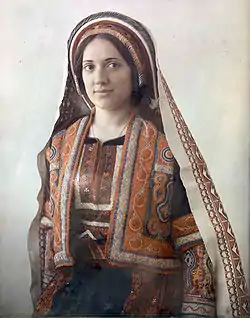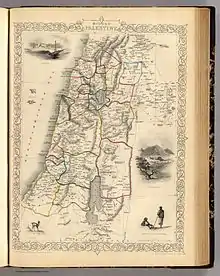Women in Palestine
Palestinian women have for a long time been involved in resistance movements in Palestine as well as in Jordan, Syria, and Lebanon. They established many female nationalist organizations, including the Palestinian Federation of Women's Action Committees in the West Bank and Gaza.[1]

| Part of a series on |
| Women in society |
|---|
 |
Despite the change in parental views, however, contemporary women in Palestine are reported to be experiencing adversity due to political discord, Israeli occupation, and the "denial of full rights and protection by Palestinian society" in general.[2]
One of the main determinants of the role of Palestinian women is the structure of the family which may be a nuclear unit, a transitional unit, or a hamula unit (hamula means "extended family", the most common family structure in Palestinian society). The significant influences to the rights of women in Palestine include the patriarchal tradition and the teachings of the Quran among Muslim Palestinians or the Bible among Palestinian Christians. On the other hand, female Palestinians were not expected to secure income for the family, but women were expected to adapt to the customary roles of women in Palestinian society. However, females are traditionally equal to men in all aspects.
However, there had been a gradual change in the attitudes of parents regarding the education of their Palestinian daughters since the middle of the 1970s. From the middle part of the 1970s, several numbers of Palestinian women achieved education from universities, instead of only receiving education at the secondary level. Reasons for the change of parental attitude were the "increased demand for women on the labour market", changes in the status of the economy in the West Bank territory, the "economic interests" of the parents, and the idea that a well-educated Palestinian woman has a better place and opportunity on the "marriage market". In addition to this, armed with earned education, an unmarried daughter can financially support herself and her parents.[3]
A survey by the Palestinian Central Bureau of Statistics from 2011 showed that 35 percent of married women in Gaza had been on the receiving end of physical violence by their husband during the previous twelve months, and that 40 percent of unmarried women had been physically abused by a member of their household.[4] In 2013, UNRWA canceled its annual marathon in Gaza after Hamas rulers prohibited women, including Palestinian women from Gaza, to participate in the race.[5]
History

There was a shift in that social order in 1844 when women first participated alongside men in protesting against the first Jewish settlements near the town of Afulah. Between 1900 and 1910, as the region of Palestine (which included what is now Jordan) was under Ottoman rule, Arab women initiated the creation of numerous associations and societies. These organizations were formed mostly in the larger cities, and especially in cities with large Christian populations such as Jaffa, Jerusalem, Haifa, and Acre.[6] In 1917, they took part in large demonstrations at the time of the Balfour Declaration, and later formed a 14-member delegation that demanded that the Balfour Declaration be revoked and that Jewish immigration to Palestine be halted. In 1921, Palestinian women organized by setting up their own society known as the Arab Women's Association, (fr) based in Jerusalem. The society organized demonstrations against the Palestinian Jewish settlements. Due to the lack of funding and the social and political pressure which was put on the women of the Arab Women's Association, the group ceased to exist after two years. Women formed a 'rescue committee' to collect donations in order to revive it. In the 1929 Palestine riots, women took part in multiple protests and demonstrations which resulted in women being killed by the British Mandate forces. They organized a Women's Conference, where they sent out a protest letter to King George V and to the League of Nations.
Following the creation of the state of Israel in 1948, the participation of Palestinian women in opposition was almost non-existent due to a strict social order in society at the time. The displacement and loss of land for the Palestinians created an economic issue. This created a demand for women in the workforce despite the social restrictions.[7]
Following the establishment of the Palestinian Liberation Organization (PLO) in 1964, helped create the sect known as the Palestinian Women’s Association, which allowed women to take part in the first session of the Palestinian National Council that was held in Jerusalem.
Israeli–Palestinian conflict
The Israeli–Palestinian conflict has seriously affected the Palestinian women. Hundreds of thousands of women were banished and displaced from their homelands after the 1948 Arab–Israeli War, and more during the 1967 War such as poet May Sayegh. The majority of them and their descendants are still refugees. Many measures taken by the Israel Defense Force (IDF) have affected the Palestinian women's physical, psychological, health, education, economic security.[8] A press release issued by the Ma'an News Agency in 2007 reported that many women suffered psychological and sexual violence at the Israeli checkpoint in Beit Safafa. These cases reported forced strip searches under the pretext of security measures.[9]
Women's rights in Palestine
In November 2019, the PA government raised the minimum marriage age to 18 for both genders in an effort to reduce rates of early marriage. Previously, the minimum age for marriage in the West Bank was 15 for females and 16 for males, while in the Gaza Strip it was 17 for females and 18 for males. Judges had the power to approve an earlier marriage. According to statistics, 37% of married Palestinian females married when they were under the age of 18, including 5% who married before the age of 15. Sixty-three percent of young married women suffer violence at the hands of their husband, and 95% would not recommend early marriage for their daughters. Child marriage is thought to contribute to the high rate of divorce in the Palestinian territories, where 67% of women who divorced in 2018 were aged 18 to 29.[10]
Divorce rights for women depend on the personal status laws that apply to Muslims, which state that a man can divorce his wife for any reason, while women can request divorce only under certain circumstances. If a woman proceeds to a divorce she does not need to present any evidence, but would give up any financial rights and must return her dowry. The Ministry of Women's Affairs in Palestine, established in 2003, is the main governmental agency responsible for promoting and protecting women's rights. Government ministries promote reform of discriminatory laws and gender units have been established in each ministry.[11]
In March 2018, the PA repealed its marry-your-rapist law, a provision that allowed an accused rapist to evade punishment by marrying his victim.[12] However, because the Gaza Strip is de facto controlled by Hamas, the Egyptian-derived marry-your-rapist law still applies there.[12]
Education of the girl
Under the Ottoman Empire
Under Ottoman occupation (1516-1917)[1], there was not enough resources invested in schooling. There were a few public and private schools located in the most populated regions which influenced the high illiteracy rate across all genders but especially for women.[13] In the mid-19th century, Christian missionaries began to come to Palestine in droves in attempts to transform and convert Palestinian communities who were referred to as “backwards” and “heathens”.[14] Due to fears of western imperialism and foreign Christian education, the Ottoman government began to emphasize state-sponsored education. In 1864, the Ottoman government created a policy that would only allow missionaries to create schools in communities with large Christian populations in order to prevent the expansion of western imperialism within the Ottoman empire. And under the reign of SultanʿAbdul Hamid II, the Law of Public Education of 1869 was implemented ten years after its creation. Under this law, elementary education was mandatory for all children under the age of 12. This piece of legislation also acknowledged the need for the education of girls as well as their education beyond the primary level; this resulted in the development of co-educational education as well as gender segregated schooling in the regions that had the finances to maintain both schools. However, the promises made by the 1869 law never came to fruition as many girls were at most able to acquire intermediate level education due to the lack of resources.
With the introduction of the press in Palestine in 1908, journalists and theorists began to openly criticize the quality of education under Christian missionaries. In 1911, the literary journal al-Nafaʾis al-ʿasriyya, a ghost writer under the initials Kh. S, wrote an article about women’s education in Greater Syria, the region which included Palestine. In the format of a dialogue between a woman and her servant, the article discusses the lack of nationalist and home management education for young girls.[14] Through the eyes of Arab Nationalists, without nationalist education in combination with training to be mothers and wives, women would not only be unable to care for their families but they would also produce generations of Arabs that did not know the Arabic language or values.[14] Many schools in the Ottoman empire, under the guise of being state-run, gave missionaries and western organizations like the American Colony the authority to administer schools.
Under British Mandate
During World War I (1914-1918), the Ottoman government faced economic, political and social hardship which resulted in the further deterioration of their schools. The casualties due to military service in WWI in combination with the famine caused by the British blockade of the Syrian coast, hundreds of thousands lost, leaving women and children to protect and defend themselves.[15] Following the war, the Ottoman Empire conceded the territory of Palestine in 1918, and following the San Remo Conference, the United Kingdom was given the mandate to provide “administrative advice and assistance” until Palestine could govern themselves (Article XXII of Covenant of the League of Nations). The British colonial administration witnessed this chaotic time and invested within education understanding that education could protect girls from the effects of the war.
The first Director of Education, Humphrey Bowman (1920-1936) expressed the need for education in order to “train up good citizens of the country.”[15] However, this intent to support the education of children, specifically girls, was neglected and communities across Palestine did not receive the resources needed to expand the education of girls. As regions had to deal with overcrowded and understaffed schools, the British enforced standards that only worsened the conditions. Regions like the district of Hebron who only had one school to support 70,000 residents (resulting in 77% of student applications being turned away), were forced to build a new girl’s school without the financial assistance of the British.[15] Due to the lack of funding, schools, especially ones for girls, were never expanded or often times, ever built. In rural villages, girls had even less access to education for financial reasons, such as the mandatory construction of separate schools for boys and girls, but as well as agricultural ones. The British were concerned that with too much education, it would be a crisis as it would “leave the fields untilled or…lessen the fitness or disposition of the people for agricultural employment” in the words of Lord Cromer, the British Consul General to Egypt.[15]
In 1920, the High Commissioner for Palestine, Herbert Samuel, approved the construction of 300 rural elementary schools for both girls and boys in four years, but by 1925, only 98 new buildings have been constructed and only 10 were for girls.[15] Additionally, A. L. Tibawi states that the British administration reduced their educational budget from £130,000 in 1921 to £97,279 in 1923-1924, while simultaneously increasing their state revenue by over a million pounds over ten years (1921-1931).[15] By the end of the Mandate period (1948), the government only administered 80 girls schools in all of Palestine with 15,303 students, and Arab girls made up only 21% of all the students in government schools.[15] Only about 7.5 percent of girls in rural areas received an education in comparison to 60% of girls in urban regions.[15]
Under Israeli Occupation
Following World War II, the United Nations divided Palestinian land into different sections. In 1948, mandatory Palestine was terminated and with the Israeli state was created. Palestinian territory was divided among Israel, Jordan, and Egypt. Although Israel annexed the land, they did not claim the people on this land which impacted the education of Palestinians;[13] The regions of East Jerusalem, the West Bank, and the Gaza Strip were required to follow Jordanian and Egyptian curriculum.[16] Even after the annexation of the West Bank by Israel in 1967, Palestinians in the regions continued to follow Jordanian curricula due to the Israeli military control over Palestine.[16] Following the signing of the Oslo Accord in 1993, Palestinians were able to create their own textbooks outside of Jordanian guidelines. From 1994 to 2000, the Palestinian authority was given the opportunity to establish their own textbooks with the supervision of the Jordanian Ministry of Education.[16]
According to a 2018 study, in the 2017-2018 academic year of the 48 licensed and accredited higher education institutions in Palestine, women made up about 60% of the student population and 23% of the academic faculty.[17] However, these statistics do not share the full experiences of students in Palestine. The Palestinian Monitoring Group has stated that Israeli military and settler activity in the Occupied Palestinian Territories (OPT) affected 28% of the Palestinian student population through killings, injuries and arrests.[18] Additionally, due to curfew imposed by the Israeli army has caused the loss of more than 1,500 school days for students between 2003 and 2005.[18]
Social Impact of Education
Since the mid-1970s, families have been moving towards educating their daughters highly and enrolling them in universities rather than just getting a high school diploma. The reason for this change is that women are becoming needed in the labor market, changing the economic situation in the West Bank. The idea that an educated young woman is desirable for marriage is firmly established.[19] Finally, the young woman is able to afford her expenses and the expenses of her family in the event of her marriage.
See also
References
- Hasso, Frances S. Resistance, Repression, and Gender Politics in Occupied Palestine and Jordan (Syracuse University Press 2005).
- Palestinian women 'suffer doubly', BBC News, March 31, 2005
- Manasra, Najah. Palestinian Women: Between Tradition and Revolution
- Odgaard, Lena (25 March 2014). "Upsurge in Palestinian 'honour killings'". Al Jazeera English. Retrieved 25 March 2014.
- "UN cancels Gaza marathon over Hamas ban on women". Times of Israel. March 5, 2013.
- Fleischman, Ellen (2003). The Nation and Its "New" Women: The Palestinian Women's Movement, 1920-1948. https://books.google.com/books?isbn=0520237900: University of California Press. pp. 103–104. ISBN 0520237897.CS1 maint: location (link)
- Kazi, Hamida. "Palestinian Women and the National Liberation Movement: A Social Perspective." N.p., 13 Nov. 2013. Web.
- "The Impact of the Conflict in the Occupied Palestinian Territory on Women". mediterraneas.org. Retrieved 2015-10-18.
- "Khouloud Daibes: Israeli soldiers forcing women to submit to strip searches at checkpoints". Ma'an News Agency. June 30, 2007.
- PA outlaws child marriage
- Suheir Azzouni. "Palestine - Palestinian Authority and Israeli Occupied Territories" (PDF). Freedom House.
- "Palestine: 'Marry-Your-Rapist' Law Repealed". Human Rights Watch. 10 May 2018. Retrieved 13 May 2018.
- Nasir-Tucktuck, Mona; Baker, Joshua N.; Love, Matthew L. (January 2017). "Educating Learners With Disabilities in Palestine: The Past, Present, and Future". Intervention in School and Clinic. 52 (3): 182–187. doi:10.1177/1053451216644821. ISSN 1053-4512 – via SAGE.
- Greenberg, Ela (2009). "Educating Girls in Late Ottoman Palestine". Preparing the Mothers of Tomorrow: Education and Islam in Mandate Palestine. ProQuest Ebook Central: Austin: University of Texas Press. pp. 15–43. ISBN 9780292793514.
- Greenberg, Ela (2009). "Removing "the Long-Standing Prejudice against Girls' Education": Government Schools and Muslim Girls during the British Mandate". Preparing the Mothers of Tomorrow : Education and Islam in Mandate Palestine. ProQuest Ebook Central: University of Texas Press. pp. 44–71. ISBN 9780292793514.
- Alayan, Samira; Al-Khalidi, Naseema (2010-03-01). "Gender and Agency in History, Civics, and National Education Textbooks of Jordan and Palestine". Journal of Educational Media, Memory, and Society. 2 (1): 78–96. doi:10.3167/jemms.2010.020105. ISSN 2041-6938.
- El-Far, Mira T.; Sabella, Anton R.; Vershinina, Natalia A. (2020-06-13). ""Stuck in the middle of what?": the pursuit of academic careers by mothers and non-mothers in higher education institutions in occupied Palestine". Higher Education. doi:10.1007/s10734-020-00568-5. ISSN 1573-174X.
- Shalhoub‐Kevorkian, Nadera (March 2008). "The gendered nature of education under siege: a Palestinian feminist perspective". International Journal of Lifelong Education. 27 (2): 179–200. doi:10.1080/02601370801936341. ISSN 0260-1370.
- Sabbah‐Karkaby, Maha; Stier, Haya (2017). "Links Between Education and Age at Marriage among Palestinian Women in Israel: Changes Over Time". Studies in Family Planning. 48 (1): 23–38. doi:10.1111/sifp.12015. ISSN 1728-4465.
| Wikimedia Commons has media related to Women of Palestine. |
